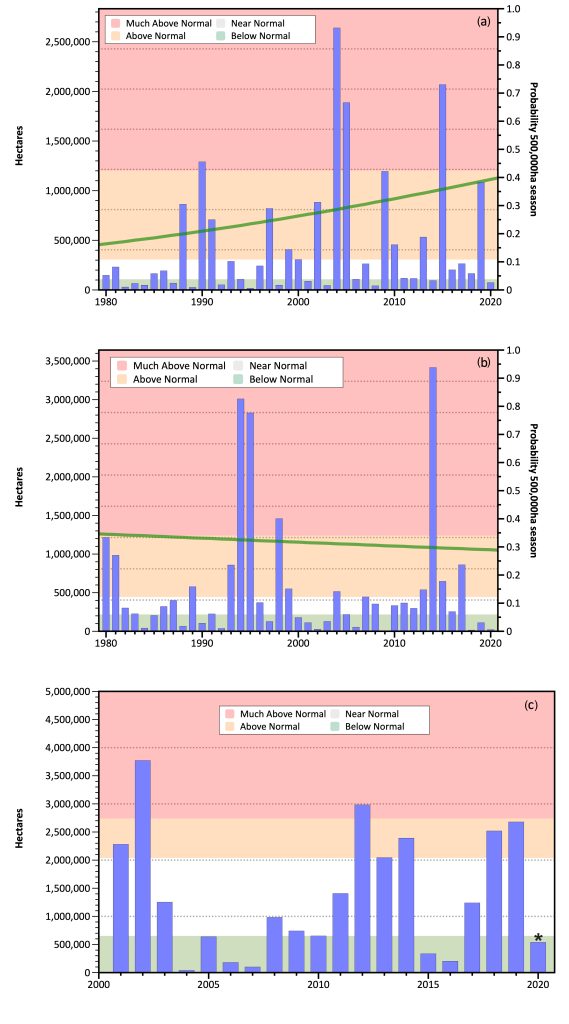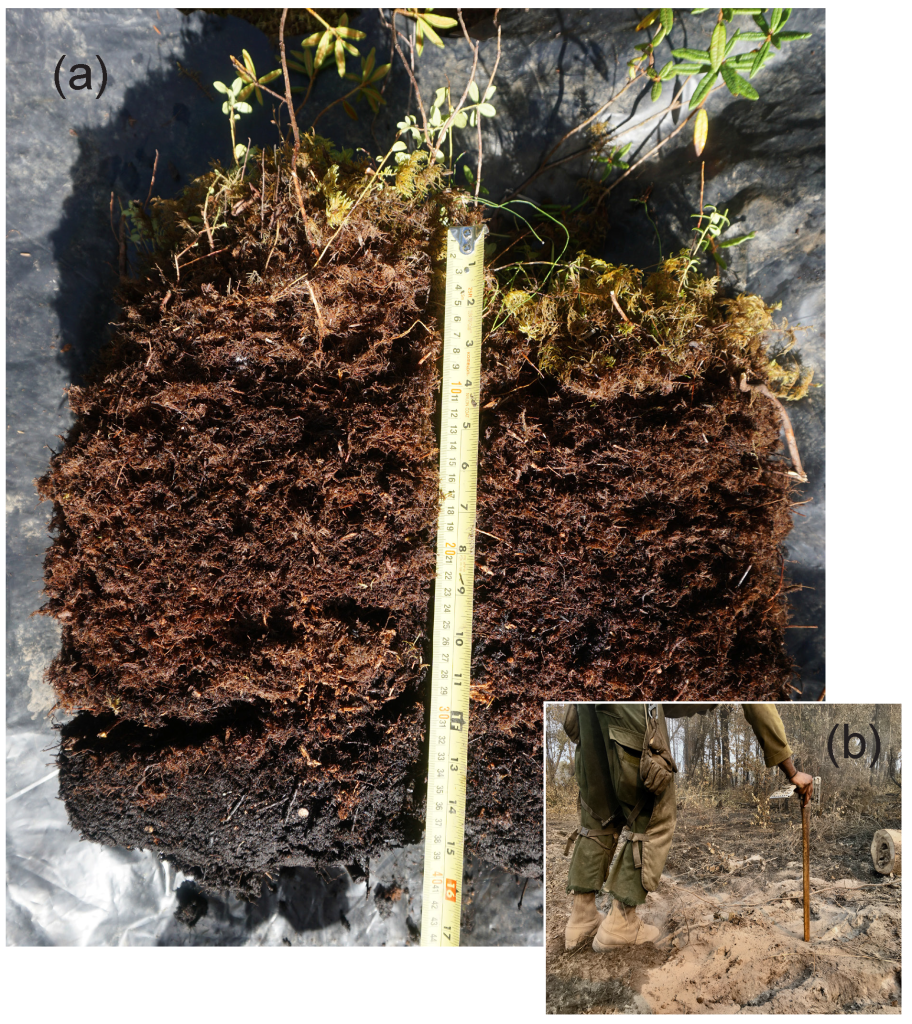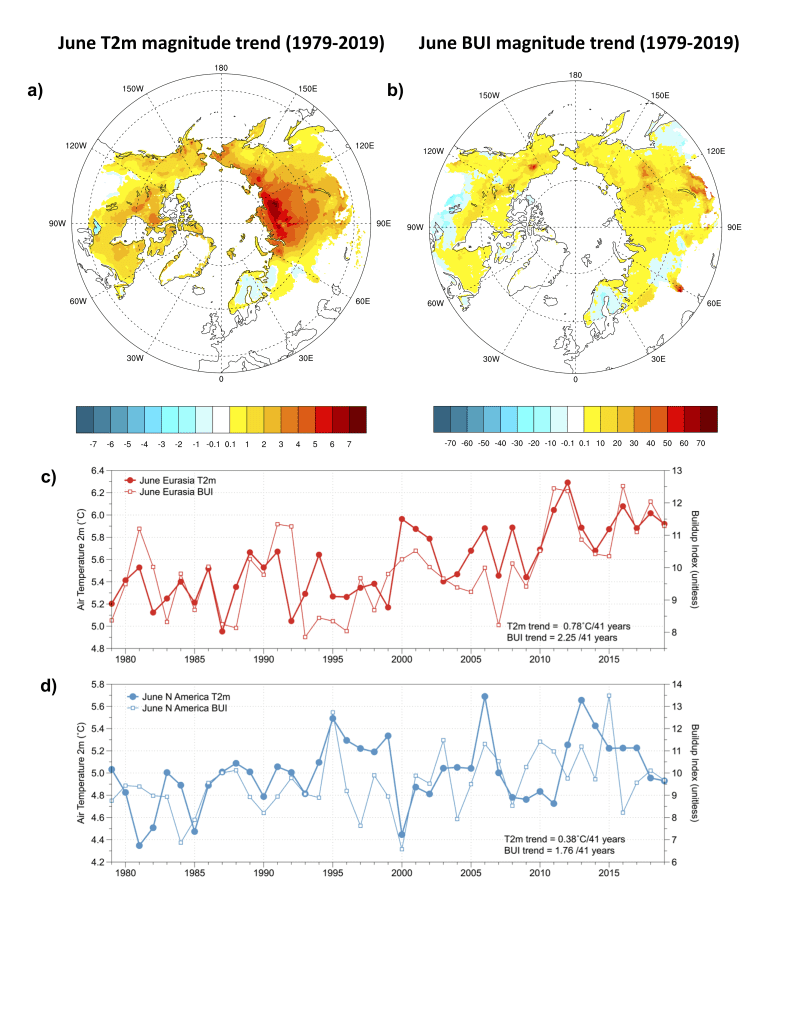A. York1, U. S. Bhatt2,3, E. Gargulinski4, Z. Grabinski1, P. Jain5, A. Soja4, R. L. Thoman6,7, and R. Ziel1
1Alaska Fire Science Consortium, International Arctic Research Center, University of Alaska Fairbanks, Fairbanks, AK, USA
2Department of Atmospheric Sciences, University of Alaska Fairbanks, Fairbanks, AK, USA
3Geophysical Institute, University of Alaska Fairbanks, Fairbanks, AK, USA
4National Institute of Aerospace, Langley Research Center, NASA, Hampton, VA, USA
5Natural Resources Canada, Canadian Forest Service, Northern Forestry Centre, Edmonton, Alberta, Canada
6Alaska Center for Climate Assessment and Policy, University of Alaska Fairbanks, Fairbanks, AK, USA
7International Arctic Research Center, University of Alaska Fairbanks, Fairbanks, AK, USA
Highlights
- Wildland fire activity in high northern latitudes is highly variable, driven by subseasonal drying over weeks, and controlled by climate.
- Under prolonged warm, dry weather conditions, the accumulated layers of partially decomposed organic matter that characterize northern ecosystems become a ready fuel source and are key to regional fire phenomena (e.g., holdover fires), to interactions with the global carbon cycle, and to impacts on other aspects of these high latitude environments.
- Increasing trends in air temperature and fuel availability over the 41-year record (1979-2019) suggest that conditions are becoming more favorable for fire growth, with more intense burning, more fire growth episodes, and greater consumption of fuels.
Introduction
Despite the low annual temperatures and short growing seasons that are characteristic of high northern latitudes (HNL), wildland fire is the dominant ecological disturbance within the region’s boreal forest, the world’s largest terrestrial biome. The boreal forest, also known as Taiga, is the band of mostly coniferous trees that stretches across the area north of the July 13°C isotherm in North America and Eurasia. Wildland fires also impact the tundra regions bordering the Taiga. This brief report updates our previous contribution to Arctic Report Card 2017. It summarizes evidence on variability and trends in fire disturbance in HNL, describes the fuels that characterize boreal and tundra ecosystems, and outlines how climate and subseasonal fire weather conditions in HNL influence the extent of area burned in a given year.
Regional variability
Long-term burned area data have been compiled for Alaska and Canada. These data are relatively more limited in Eurasia and arctic tundra regions, presenting challenges to developing a robust circumpolar perspective (Kukavskaya et al. 2013; Duncan et al. 2020). Figure 1 shows the geographic extent (Fig. 1a) and time series (Fig. 1b) of annual cumulative end-of-season burned area in circumpolar HNL from 55° N to 70° N for 2001-June 2020, generated using the MODIS Global Burned Area Collection 6 Product (MCD64A1; Giglio et al. 2018). Figure 2 shows annual burned area per year in Alaska and the Northwest Territories since 1980 and in the Republic of Sakha in Siberia since 2001, including both boreal and tundra regions. These records show considerable interannual variability and that large fire years in these three regions are not coincident. Alaska and the Northwest Territories have sufficiently long time series to allow an estimate of the trend via logistic regression of large (>500,000 ha) fire seasons as shown in Fig. 2a, b. The results illustrate that high-latitude wildfire varies both geographically and across decadal timeframes, with large fire seasons becoming more likely in Alaska over the past 40 years but slightly declining in the Northwest Territories.




Most area burned in HNL occurs during sporadic episodes of large fire growth, preceded by extended periods of drying and accompanied by anomalously hot and dry conditions (Flannigan et al. 2009). For example, 50% of the area burned in Alaska from 2002 to 2010 was consumed in just 36 days (Barrett et al. 2016). Significant weather events, such as prolonged warm dry weather, associated with blocking high pressure systems, and convective lightning storms are responsible for much of the variability in fire history (Hayasaka et al. 2016). In both Alaska and Canada, lightning-caused fires are responsible for the majority of area burned (AICC 2020; Hanes et al. 2019), in part because lightning-ignited fires are more likely to be remote and subject to lower levels of suppression, compared to human-caused fires.
Recent large fire seasons in HNL driven by unusually warm and dry conditions include:
- 2018 in Sweden, where record May and July temperatures led to burned area of 24 thousand ha, more than 8 times the 2008-17 average (San-Miguel-Ayanz et al. 2019)
- 2019 in Alaska (Fig 2a), where 719 fires burned more than 1 million ha. Drought- and wind-driven fires in late August destroyed homes, businesses, and electric power infrastructure, and disrupted tourism and other economic activity (AICC 2020)
- The 2019 and 2020 fire seasons in Sakha (Fig 2c), which are unprecedented in the 20-year MODIS record in terms of an earlier start to the fire season and their northern extent, with some fires burning only about 11 km from the Chukchi Sea. From March through June in both 2019 and 2020, burned area was greater than 2.9 times the 20-year mean. Typically, most burning in such HNL occurs in July. Fires burned primarily in montane sub-arctic ecosystems across landscapes underlain by permafrost. (See essay Surface Air Temperature for information on the extreme temperature departures associated with these fires.)
Beyond immediate threats to lives and property, wildland fire has multiple impacts on HNL environments and residents. Smoke can be widespread and compromise human health, particularly in vulnerable populations. Wildfire smoke also limits visibility and constrains aviation operations, including those supporting fire suppression and detection. Black carbon derived from wildfires travels considerable distances, up to 4000 km or more, and accelerates surface melting and thawing of snow and ice by lowering the surface albedo (Thomas et al. 2017). Combustion removes the insulation provided by soil organic matter and accelerates permafrost degradation and associated disturbance of the land surface in both boreal and tundra soils, which can have multiple impacts (Jones et al. 2015). For example, the thawing of ice-rich permafrost (thermokarst) may lead to surface subsidence and hydrological changes (Romanovsky et al. 2017).
Climatological and ecosystem influences
Climate is a dominant control of fire activity on interannual and decadal scales. The relationship between climate and fire is strongly nonlinear in both boreal and tundra ecosystems, with the likelihood of fire occurrence within a 30-year period much higher where mean July temperatures exceed 13.4°C (56°F) (Young et al. 2017). HNL fire regimes appear to be responding to recent environmental changes associated with the warming climate (Soja et al. 2007; Hanes et al. 2019). Although highly variable, burned area has increased over the past several decades in much, but not all, of boreal North America (Hanes et al. 2019 and references therein). Lightning ignitions have increased in the region since 1975 and largely drove the extreme 2014 Northwest Territories and 2015 Alaska fire seasons (Veraverbeke et al. 2017). In Alaska, lightning activity increased during 1986-2015, as did summer temperatures (Bieniek et al. 2020). Partain et al. (2016) found that recent anthropogenically driven climate change increased the likelihood of the extremely dry fuel conditions seen in Alaska in 2015 by 34-60%.
Dominant vegetation varies considerably across the HNL, and species-specific traits in the conifers that carry fire in boreal forests affect regional fire regimes (Rogers et al. 2015). HNL ecosystems are also characterized by extremely limited decomposition due to low average annual air temperatures. Accumulated partially decomposed organic matter is widespread in boreal and arctic systems, often forming thick layers of potentially flammable carbon-rich moss (i.e., duff) and peat, generally termed soil organic matter (Fig.3a). This large pool of biomass is estimated to contain 30-40% of global soil carbon (Lorenz and Lal 2010). Under long daylengths in June and July, these fuelbeds can dry rapidly over weeks (versus seasonal curing in arid climates at lower latitudes), increasing flammability even before drought reaches significant levels (Ziel et al. 2020). Once established in these fuels, fires can smolder for long periods and may form deep hot ash pits (Fig. 3b) that can overwinter to re-emerge in spring (Wheeling, 2020). At least 10 fires overwintered in the Northwest Territories from 2014-2015 (Wohlberg 2015) and at least 40 in Alaska from 2005-2020 (AICC 2020). Satellite imagery suggests that a large number of overwintering fires in Siberia from 2019 jumpstarted the 2020 season (Wheeling, 2020).


The combustion of soil organic matter in boreal and arctic fires has large impacts on the global carbon cycle, including potential positive feedbacks to climate warming through direct emissions from combustion and accelerated decomposition and thermokarsting (Walker et al. 2019). Additional feedbacks from fire to HNL ecosystems include interactions with vegetation succession (Mekonnen et al. 2019 and references therein), biogeochemical cycles (Bond-Lamberty et al. 2007), energy balance (Potter et al. 2019), and hydrology (Liu et al. 2005).
Reflecting the importance of cumulative drying on fuelbed flammability, the Canadian Forest Fire Danger Rating System (CFFDRS) uses its Buildup Index (BUI) (Wotton 2009) as a numerical rating of fuel availability for consumption. BUI is derived from daily accounting of surface temperature, relative humidity, and 24-hour rainfall totals. In boreal and arctic systems BUI reflects the flammability of duff fuels below the surface. As BUI crosses significant thresholds, fires can burn more intensely, spread more aggressively, and pose more problems for suppression. Surface air temperatures effectively represent the influence of solar radiation and moisture deficits as well as fuel heating on ignition and fire spread.
Figure 4 shows 2 m air temperature and BUI trends and time series for boreal and tundra regions of Eurasia and North America in June for the 41-year period of record (1979-2019), calculated using the European Center Reanalysis version 5 (ERA5) (McElhinny et al. 2020). Widespread increases in temperature and BUI in both June and July (data not shown) and on both continents suggest that conditions are becoming more favorable for fire growth, with increases in cumulative drying and flammability likely to result in more intense burning, more fire growth episodes, and greater consumption of fuels.


These observations of area burned, BUI, and temperature are consistent with analyses projecting significant increases (up to four-fold) in burned area in HNL ecosystems by the end of the 21st century under a range of climate change scenarios (French et al. 2015; Young et al. 2017; Yue et al. 2015, and references therein). Because specific fire events depend on multiple interacting factors, the resulting changes in HNL fire regimes will vary greatly over space and time. However, all evidence indicates that northern ecosystems will become increasingly vulnerable to wildland fire and its impacts.
References
Alaska Interagency Coordination Center (AICC), 2020: Alaska fire history data. https://fire.ak.blm.gov/predsvcs/intel.php, accessed 10 September 2020.
Barrett, K., T. Loboda, A. D. McGuire, H. Genet, E. Hoy, and E. Kasischke, 2016: Static and dynamic controls on fire activity at moderate spatial and temporal scales in the Alaskan boreal forest. Ecosphere, 7(11), e01572, https://doi.org/10.1002/ecs2.1572.
Bieniek, P. A., U. S. Bhatt, A. York, J. E. Walsh, R. Lader, H. Strader, R. H. Ziel, R. R. Jandt, and R. L. Thoman, 2020: Lightning variability in dynamically downscaled simulations of Alaska’s present and future summer climate. J. Appl. Meteor. Climatol., 59, 1139-1152, https://doi.org/10.1175/JAMC-D-19-0209.1.
Bond-Lamberty, B., S. D. Peckham, D. E. Ahl, and S. T. Gower, 2007: Fire as the dominant driver of central Canadian boreal forest carbon balance. Nature, 450(7166), 89-92. https://doi.org/10.1038/nature06272.
Canadian National Forestry Database, 2020: Area burned by jurisdiction. http://nfdp.ccfm.org/en/data/fires.php, accessed September 10, 2020.
Duncan, B. N., and Coauthors, 2020: Space-based observations for understanding changes in the arctic-boreal zone. Rev. Geophys., 58, e2019RG000652, https://doi.org/10.1029/2019RG000652.
Flannigan, M., B. Stocks, M. Turetsky, and M. Wotton, 2009: Impacts of climate change on fire activity and fire management in the circumboreal forest. Glob. Change Biol., 15, 549-560, https://doi.org/10.1111/j.1365-2486.2008.01660.x.
French, N. H. F., L. K. Jenkins, T. V. Loboda, M. Flannigan, R. Jandt, L. L. Bourgeau-Chavez, and M. Whitley, 2015: Fire in arctic tundra of Alaska: past fire activity, future fire potential, and significance for land management and ecology. Int. J. Wildland Fire, 24(8), 1045-1061, https://doi.org/10.1071/WF14167.
Giglio, L., L. Boschetti, D. P. Roy, M. L. Humber, and C. O. Justice, 2018: The Collection 6 MODIS burned area mapping algorithm and product. Remote Sens. Environ., 217, 72-85. https://doi.org/10.1016/j.rse.2018.08.005.
Hanes, C. C., X. Wang, P. Jain, M. A. Parisien, J. M. Little, and M. D. Flannigan, 2019: Fire-regime changes in Canada over the last half century. Can. J. For. Res., 49(3), 256-269, https://doi.org/10.1139/cjfr-2018-0293.
Hayasaka, H., H. L. Tanaka, and P. A. Bieniek, 2016: Synoptic-scale fire weather conditions in Alaska. Polar Sci., 10(3), 217-226, https://doi.org/10.1016/j.polar.2016.05.001.
Jones, B., G. Grosse, C. D. Arp, E. A. Miller, L. Liu, D. J. Hayes, and C. F. Larsen, 2015: Recent Arctic tundra fire initiates widespread thermokarst development. Sci. Rep., 5, 15865, https://doi.org/10.1038/srep15865.
Kukavskaya, E. A., A. J. Soja, A. P. Petkov, E. I. Ponomarev, G. A. Ivanova, and S. G. Conard, 2013: Fire emissions estimates in Siberia: evaluation of uncertainties in area burned, land cover, and fuel consumption. Can. J. For. Res., 43, 493-506, https://doi.org/10.1139/cjfr-2012-0367.
Liu, H., J. T. Randerson, J. Lindfors, and F. S. Chapin, 2005: Changes in the surface energy budget after fire in boreal ecosystems of interior Alaska: An annual perspective. J. Geophys. Res., 110(D13), D13101, https://doi.org/10.1029/2004JD005158.
Lorenz, K., and R. Lal, 2010: Carbon Sequestration in Forest Ecosystems, pp. 159-205, Springer Netherlands, https://doi.org/10.1007/978-90-481-3266-9.
McElhinny, M., J. F. Beckers, C. Hanes, M. Flannigan, and P. Jain, 2020: A high-resolution reanalysis of global fire weather from 1979 to 2018 – overwintering the Drought Code. Earth Syst. Sci. Data, 12, 1823-1833, https://doi.org/10.5194/essd-12-1823-2020.
Mekonnen, Z. A., W. J. Riley, J. T. Randerson, R. F. Grant, and B. M. Rogers, 2019: Expansion of high-latitude deciduous forests driven by interactions between climate warming and fire. Nat. Plants, 5, 952-958, https://doi.org/10.1038/s41477-019-0495-8.
Partain, J. L., and Coauthors, 2016: An assessment of the role of anthropogenic climate change in the Alaska fire season of 2015 [in “Explaining Extremes of 2015 from a Climate Perspective”]. Bull. Amer. Met. Soc., 97(12), S14-S18, https://doi.org/10.1175/BAMS-D-16-0149.1.
Potter, S., and Coauthors, 2019: Climate change decreases the cooling effect from postfire albedo in boreal North America. Glob. Change Biol., 26, 1592-1607, https://doi.org/10.1111/gcb.14888.
Romanovsky, V., and Coauthors, 2017: Changing permafrost and its impacts. In: Snow, Water, Ice and Permafrost in the Arctic (SWIPA) 2017. pp. 65-102. Arctic Monitoring and Assessment Programme (AMAP), Oslo, Norway.
Rogers, B. M., A. J. Soja, M. L. Goulden, and J. T. Randerson, 2015: Influence of tree species on continental differences in boreal fires and climate feedbacks. Nat. Geosci., 8(3), 228-234, https://doi.org/10.1038/ngeo2352.
San-Miguel-Ayanz, J., and Coauthors, 2019: Forest Fires in Europe, Middle East and North Africa 2018. EUR 29856 EN, Publications Office of the European Union, Luxembourg. https://doi.org/10.2760/1128.
Soja, A. J., and Coauthors, 2007: Climate-induced boreal forest change: predictions versus current observations. Glob. Planet. Change, 56, 274-296, https://doi.org/10.1016/j.gloplacha.2006.07.028.
Thomas, J. L., and Coauthors, 2017: Quantifying black carbon deposition over the Greenland ice sheet from forest fires in Canada. Geophys. Res. Lett., 44, 7965-7974, https://doi.org/10.1002/2017GL073701.
Veraverbeke, S., B. M. Rogers, M. L. Goulden, R. R. Jandt, C. E. Miller, E. B. Wiggins, and J. T. Randerson, 2017: Lightning as a major driver of recent large fire years in North American boreal forests. Nat. Climate Change, 7, 529-534, https://doi.org/10.1038/nclimate3329.
Walker, X. J., and Coauthors, 2019: Increasing wildfires threaten historic carbon sink of boreal forest soils. Nature, 572, 520-523, https://doi.org/10.1038/s41586-019-1474-y.
Wheeling, K., 2020: The rise of zombie fires. Eos, 101, https://doi.org/10.1029/2020EO146119.
Wohlberg, M., 2015: ‘Well on our way to another record drought code year’: NWT fire manager. Northern Journal, June 23, 2015, https://norj.ca/2015/06/well-on-our-way-to-another-record-drought-code-year-nwt-fire-manager/.
Wotton, B. M., 2009: Interpreting and using outputs from the Canadian Forest Fire Danger Rating System in research applications. Environ. Ecol. Stat., 16, 107-131, https://doi.org/10.1007/s10651-007-0084-2.
Young, A. M., P. E. Higuera, P. A. Duffy, and F. S. Hu, 2017: Climatic thresholds shape northern high-latitude fire regimes and imply vulnerability to future climate change. Ecography, 40, 606-617, http://dx.doi.org/10.1111/ecog.02205.
Yue, X., L. J. Mickley, J. A. Logan, R. C. Hudman, M. V. Martin, and R. M. Yantosca, 2015: Impact of 2050 climate change on North American wildfire: consequences for ozone air quality. Atmos. Chem. Phys., 15, 10033-10055, https://doi.org/10.5194/acp-15-10033-2015.
Ziel, R. H., P. A. Bieniek, U. S. Bhatt, H. Strader, T. S. Rupp, and A. York, 2020: A comparison of fire weather indices with MODIS fire days for the natural regions of Alaska. Forests, 11, 516, https://doi.org/10.3390/f11050516.
November 12, 2020
